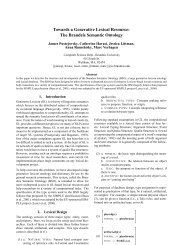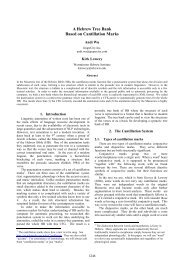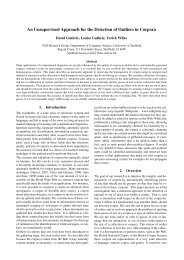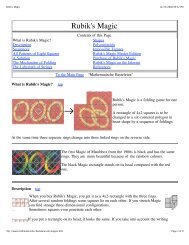The Google File System
The Google File System
The Google File System
You also want an ePaper? Increase the reach of your titles
YUMPU automatically turns print PDFs into web optimized ePapers that Google loves.
<strong>The</strong> <strong>Google</strong> <strong>File</strong> <strong>System</strong><br />
By Sanjay Ghemawat, Howard Gobioff, and<br />
Shun-Tak Leung<br />
(Presented at the 19th ACM Symposium on<br />
Operating <strong>System</strong>s Principles)<br />
Introduction<br />
• <strong>Google</strong> – a well known search engine.<br />
• In-house applications process large<br />
amounts of data.<br />
• <strong>Google</strong> needs a distributed file system that<br />
matches its applications needs.<br />
• This paper discusses the solution: <strong>Google</strong><br />
<strong>File</strong> <strong>System</strong> (GFS).
Topics<br />
• GFS Design Motivations<br />
• GFS Architecture<br />
• Distributed Read/Write Algorithms<br />
• <strong>System</strong> Interactions<br />
• Fault-Tolerance Techniques<br />
• Performance Results<br />
<strong>Google</strong> Architecture Facts<br />
• More than 15,000 commodity-class PC's.<br />
• Fault-tolerance provided in software.<br />
• More cost-effective solution.<br />
• Multiple clusters distributed worldwide.<br />
• One query reads 100's of MB of data.<br />
• One query consumes 10's of billions of CPU cycles.<br />
• Thousands of queries served per second.<br />
• <strong>Google</strong> stores dozens of copies of the entire Web!<br />
Conclusion: Need large, distributed, highly fault-tolerant<br />
file system.
Example: Serving a Query<br />
Overview<br />
• http://www.google.com/search?q=google+file+sy<br />
stem<br />
• Browser gets load-balanced I.P. address from<br />
DNS.<br />
• Browser sends HTTP request to <strong>Google</strong> cluster.<br />
• <strong>Google</strong> Web Server (GWS) is chosen to<br />
coordinate the response.<br />
• Response generation is parallelized over<br />
multiple machines.<br />
• <strong>Google</strong> Web Server sends results formatted as<br />
HTML back to browser.<br />
Example: Serving a Query<br />
Response Generation
Example: Serving a Query<br />
Response Generation<br />
• For each word in the query, GWS gets a set of<br />
docID’s from the Index Servers.<br />
• GWS intersects the docID sets and orders them<br />
using the PageRank algorithm.<br />
• GWS gets title, link, and paragraph information<br />
for each docID from the “Document Servers”.<br />
• GWS also communicates with the Ad and Spellchecking<br />
Servers.<br />
• Results are formatted as HTML and sent back.<br />
Example: Serving a Query<br />
Response Generation<br />
• Note how one response generation is<br />
distributed over many machines:<br />
• Spell checker<br />
• Index servers<br />
• Document servers<br />
• Ad servers
Design Motivations<br />
1. GFS runs on a large number of machines.<br />
Failures occur regularly, so fault-tolerance and<br />
auto-recovery need to be built in.<br />
2. <strong>File</strong> sizes are much larger. Standard I/O<br />
assumptions (e.g. block size) have to be reexamined.<br />
3. Record appends are the prevalent form of<br />
writing. Need good semantics for concurrent<br />
appends to the same file by multiple clients.<br />
4. <strong>Google</strong> applications and GFS are both<br />
designed in-house - so they can and should be<br />
co-designed.<br />
GFS Architecture<br />
Analogy<br />
• On a single-machine FS:<br />
– An upper layer maintains the metadata.<br />
– A lower layer (i.e. disk) stores the data in<br />
units called “blocks”.<br />
• In the GFS:<br />
– A master process maintains the metadata.<br />
– A lower layer (i.e. a set of chunkservers)<br />
stores the data in units called “chunks”.
GFS Architecture<br />
Diagram<br />
GFS Architecture<br />
Overview<br />
1. Master:<br />
– Single process running on a separate machine.<br />
– Maintains metadata (file namespace, access control information, file to chunk<br />
mappings, chunk replica locations).<br />
2. Chunkserver:<br />
– A machine with Linux FS.<br />
– Stores chunks as files. Chunk size – 64 MB!<br />
– Each chunk is identified by a globally unique handle.<br />
– Chunks are replicated over multiple machines for fault-tolerance (Default: 3).<br />
– <strong>The</strong>re are hundreds of chunkservers in a GFS cluster distributed over multiple<br />
racks.<br />
3. Client (many of them):<br />
– <strong>Google</strong> application with GFS client linked in.<br />
– Gets necessary metadata for read/write operations from master.<br />
– Actual read/write only involves data flowing between client and chunkserver.
Distributed Read Algorithm<br />
1. Client application originates read request (file,<br />
byte range).<br />
2. Linked-in GFS client translates to (file, chunk<br />
index) and sends to master.<br />
3. Master responds with chunk handle and<br />
locations of all chunk replicas.<br />
4. Client chooses chunkserver and reads replica<br />
from it.<br />
Distributed Write Algorithm<br />
1. Client application originates write request.<br />
2. Linked-in GFS client translates to (file, chunk<br />
index) and sends to master.<br />
3. Master replies with primary/secondary replica<br />
locations.<br />
4. Client pushes write data to all replica locations.<br />
Note: data is stored in buffers, but not yet<br />
written.<br />
5. Primary looks at all instances of write data for<br />
the chunk in its buffer and chooses serial<br />
order.
Distributed Write Algorithm<br />
6. Primary performs the writes in that order.<br />
7. Primary communicates the serial order to the<br />
secondaries and they also write to disk.<br />
8. Secondaries report back to primary. Primary reports to<br />
client.<br />
9. If error occurs at any of replicas, client retries write.<br />
Note: This algorithm allows multiple clients to write the<br />
same chunk in parallel, because of the serial order<br />
mechanism.<br />
Record Append Algorithm<br />
Important operation for <strong>Google</strong> applications:<br />
• Merging results from multiple machines.<br />
• <strong>File</strong> used as producer - consumer queue.<br />
1. Client sends (file, chunk index) request to master.<br />
2. Master replies with primary/secondary replica<br />
locations.<br />
3. Client pushes write data to all replica locations.<br />
4. Primary checks if write extends beyond chunk<br />
boundary.
Record Append Algorithm<br />
1. If yes:<br />
1. Primary pads its chunk.<br />
2. Primary tells secondaries to pad their chunks.<br />
3. Primary informs client and tells him to retry on next chunk.<br />
2. If no:<br />
1. Primary appends to its chunk.<br />
2. Primary tells secondaries to append to their chunks.<br />
3. Finally, primary reports success to client.<br />
3. If error occurs at any of replicas, client retries write.<br />
Note: This algorithm allows multiple clients to append to the same file in<br />
parallel.<br />
Master Chunkservers<br />
• Master communicates with chunkservers<br />
regularly to obtain state:<br />
– Is chunkserver up or down?<br />
– Are there any disk failures on chunkserver?<br />
– Are any replicas corrupted?<br />
– Are there any stale replicas (chunkserver was down<br />
during a write to one of its replicas)?<br />
– Which chunk replicas does this chunkserver store?<br />
• … and to send instructions.
Master Operations<br />
• Master manages file namespace.<br />
• Master periodically scans through its entire state<br />
in the background during which it performs the<br />
following operations:<br />
– Re-replicating chunks when:<br />
– Replica quota for a chunk is increased.<br />
– When a chunkserver with a replica is down.<br />
– When a replica becomes corrupted..<br />
– Rebalancing chunks regularly for load balancing.<br />
– Managing garbage collection (deleting file and chunk<br />
metadata for deleted files).<br />
Fault Tolerance Mechanisms<br />
• Fast Recovery: master and chunkservers are designed<br />
to restart and restore state in a few seconds.<br />
• Chunk Replication: across multiple machines, across<br />
multiple racks.<br />
• Master Replication:<br />
– Master state is replicated on multiple machines.<br />
– Master operation log and checkpoints also replicated on multiple<br />
machines.<br />
– Monitoring process automatically starts up new master process if the<br />
old one fails.<br />
– “Shadow” masters for reading data if “real” master is down.<br />
• Data integrity verification accomplished through<br />
checksums.
Performance Results<br />
Test Cluster<br />
• Performance measured on cluster with:<br />
–1 master<br />
– 16 chunkservers<br />
– 16 clients<br />
• Each server machine connected to central<br />
switch by 100 Mbps Ethernet.<br />
• Each client machine also connected to<br />
central switch by 100 Mbps Ethernet.<br />
• Both switches connected with a 1 Gbps<br />
link.<br />
Performance Results<br />
Test Cluster
Performance Results<br />
Test Cluster<br />
Performance Results<br />
Real-world Clusters<br />
• Cluster A:<br />
• Used for research and development.<br />
• Used by over a hundred engineers.<br />
• Typical task initiated by user and runs for a few hours.<br />
• Task reads MB’s-TB’s of data, transforms/analyzes the data,<br />
and writes results back.<br />
• Cluster B:<br />
• Used for production data processing.<br />
• Typical task runs much longer than a Cluster A task.<br />
• Continuously generate and process multi-TB data sets<br />
• Human users rarely involved.<br />
• Clusters have been running for about a week<br />
when measurements were taken.
Performance Results<br />
Real-world Clusters<br />
Cluster Characteristics<br />
Performance Results<br />
Real-world Clusters<br />
Performance Metrics for Clusters
Performance Results<br />
Real-world Clusters<br />
An experiment in recovery time:<br />
• One chunkserver in Cluster B killed.<br />
• Chunkserver has 15,000 chunks containing 600<br />
GB of data.<br />
• Limits imposed:<br />
• Cluster can only perform 91 concurrent clonings (40% of<br />
number of chunkservers).<br />
• Each clone operation can consume at most 6.25 MB/s.<br />
• Took 23.2 minutes to restore all the chunks.<br />
• This is 440 MB/s.<br />
Conclusion<br />
• Implementation of GFS was motivated by needs<br />
specific to <strong>Google</strong>’s workload.<br />
• GFS is a successful distributed file system<br />
running on a large amount of commodity<br />
machines.<br />
• Distributed Read / Write / Record Append<br />
algorithms were discussed.<br />
• Fault-tolerance is built into the system which<br />
automatically monitors itself.<br />
• Performance results indicate that the system is a<br />
viable solution to <strong>Google</strong>’s needs.
















